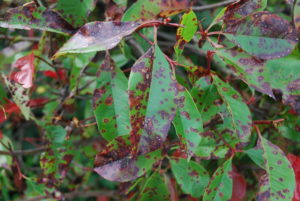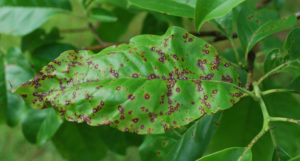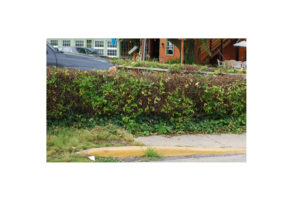
Photo: Rich Buckley
It was brought to my attention this morning that many landscapers and plant professionals are concerned by a reddening and spotting discoloration condition on Photinia foliage. Most often this is caused by the fungal pathogen Entomosporium maculatum, a widespread and destructive foliar disease of woody ornamentals in the rose family (including Photinia, Indian Hawthorn, Loquat, flowering and fruiting Pear, Firethorn, Hawthorn, Juneberry, and Quince). This pathogen discolors foliage to an unsightly red, orange, and black spotting that ultimately leads to premature defoliation. The spots will eventually turn necrotic and fungal structures will be visible within those areas (little black dots).

Photo: Rich Buckley
The pathogen can be active from late winter to late fall, favoring conditions that promote humidity and reduced airflow. The pathogen survives on infected leaves (attached or dropped). Typically it takes approximately 2 weeks for symptom development to occur post infection. Therefor the heavy discoloration we are seeing right now is the culmination of multiple infection events, where protectant fungicides were not used or were used correctly.
This means that another round of infections will occur again soon in severely infected locations as the spots will give rise to a new generation of spores.
Disease management (fungicides): Ideally, protectant fungicide applications would have been initiated every 7-14 days post bud break until all leaves had matured. However, in the current situation many people will be playing catch up. Fungicide applications initiated now will not make the symptoms go away or ‘cure’ the plant, but they are required now to protect foliage from the next wave of fungal infections and reduce the overall population. In severely infected plantings, fungicide applications should be continued every 10-14 (depending on fungicide label) days throughout the remainder of the season, especially in high value plantings or in specimen blocks. If winter conditions are unseasonably warm and humid, then applications should continue accordingly. Systemic fungicides should also be considered in addition to protective and cultural control mechanisms in severe cases.
Fungicides:
ROTATE between Fungicide Resistance Action Committee (FRAC codes)
Format: [FRAC code]: Chemical name (Trade names)
- [M05]: Chlorothalonil (Daconil WS)
- [M05 + 1] Chlorothalonil + Thiophanate methyl (Spectro 90WDG)
- [1] Thiophanate methyl (Clearys 3336)
- [11] Azxystrobin (Heritage 50W)
- [3] Myclobutanil (Eagle 40W)
- [3] Propiconazole (Banner Maxx)
- [3] Triadimefon (Bayleton 50, Strike 50WDG)
- [1 + M03] Thiophanate methyl + Mancozeb (Duosan 79W)
- [M03] Mancozeb
- [M01] Copper Oxychloride + Copper Hydroxide (Badge SC, many)
IT IS CRITICAL TO ROTATE BETWEEN FRAC CODES DUE TO THE NUMBER OF POTENTIAL APPLICATIONS
Always refer to the label for allowable host crops, use-restrictions, application rates, reapplication intervals, re-entry intervals (REI), and mix compatibility information.
DISCLAIMER: Production and pesticide information on this site are for commercial operators and landscape professionals only and are NOT for home gardener use. Provided materials represent examples and do not cover all possible control scenarios. Please contact your local agent or chemical sales representative for more information.
Click here for a list of materials available to both homeowners and licensed pesticide applicators
Cultural prevention and mitigation:
- Remove leaf-litter prior to bud break. During the season remove leaf litter only when dry. Infected leaves serve as inoculum for the next season. In severely infected plantings remove and replace mulch as fungal material can be deposited within the litter. Do not use leaf blowers to remove leaf-litter (all that does is spread around the spores).
- Avoid overhead irrigation. Water moving through the canopy represents at least two dangerous plant pathogen situations; increased leaf wetness that lets pathogens infect successfully, and movement of spores (from sporulating leaves and young growth).
- Increase airflow. Like all plant diseases, any situation that increases airflow, will decrease leaf wetness. This could include pruning, decreasing the density of plants, greater spacing, and planting/rearing site selection.
- Pruning in heavily infected plants. In addition to promoting increased air flow, heavy pruning may be required to remove overwintering inoculum from the plants. This should only be done during dry conditions, preferably during plant dormancy periods.
For sample identification please contact the Plant Diagnostic Lab here at Rutgers.

Photo: Rich Buckley
For more information and tips please visit:
Controlling Entomosporium Leaf Spot on Woody Ornamentals
Photinia Leaf Spot – Prevention And Treatment Of Common Photinia Bush Diseases
Entomosporium Leaf spot of Photinia and Indian Hawthorn
Entomosporium Leaf Spot Diagnostic Guide
Timothy J. Waller, Ph.D. (twaller@njaes.rutgers.edu)

